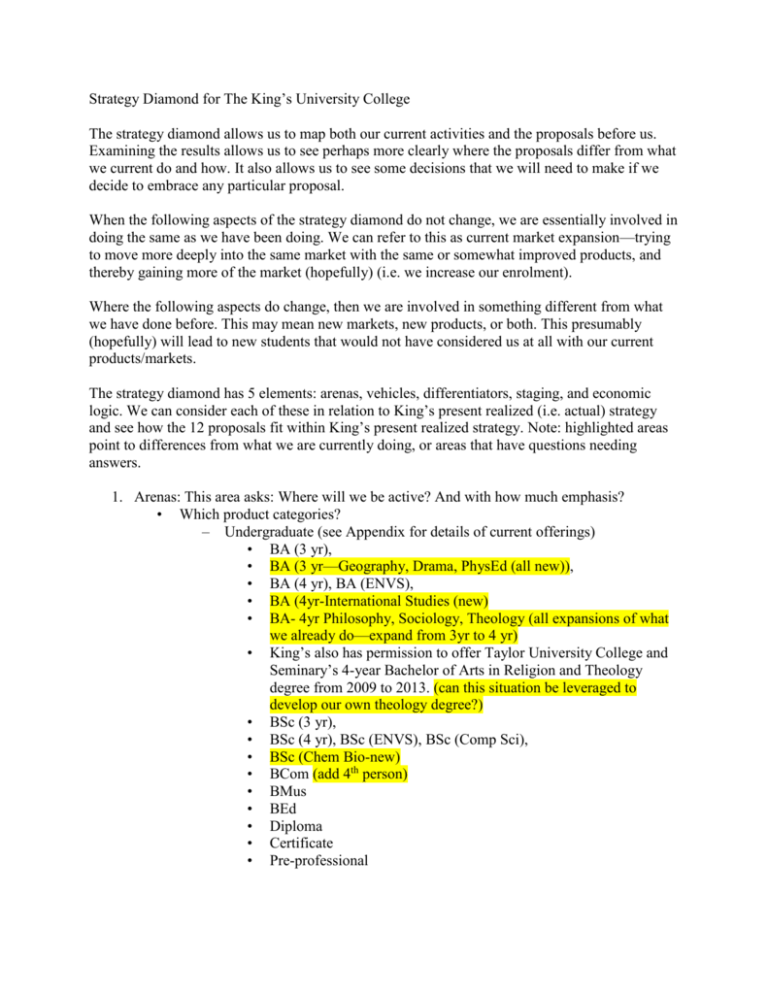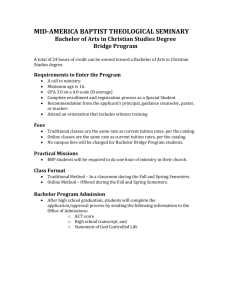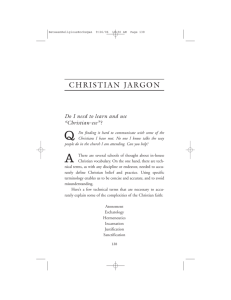Elden Wiebe
advertisement

Strategy Diamond for The King’s University College The strategy diamond allows us to map both our current activities and the proposals before us. Examining the results allows us to see perhaps more clearly where the proposals differ from what we current do and how. It also allows us to see some decisions that we will need to make if we decide to embrace any particular proposal. When the following aspects of the strategy diamond do not change, we are essentially involved in doing the same as we have been doing. We can refer to this as current market expansion—trying to move more deeply into the same market with the same or somewhat improved products, and thereby gaining more of the market (hopefully) (i.e. we increase our enrolment). Where the following aspects do change, then we are involved in something different from what we have done before. This may mean new markets, new products, or both. This presumably (hopefully) will lead to new students that would not have considered us at all with our current products/markets. The strategy diamond has 5 elements: arenas, vehicles, differentiators, staging, and economic logic. We can consider each of these in relation to King’s present realized (i.e. actual) strategy and see how the 12 proposals fit within King’s present realized strategy. Note: highlighted areas point to differences from what we are currently doing, or areas that have questions needing answers. 1. Arenas: This area asks: Where will we be active? And with how much emphasis? • Which product categories? – Undergraduate (see Appendix for details of current offerings) • BA (3 yr), • BA (3 yr—Geography, Drama, PhysEd (all new)), • BA (4 yr), BA (ENVS), • BA (4yr-International Studies (new) • BA- 4yr Philosophy, Sociology, Theology (all expansions of what we already do—expand from 3yr to 4 yr) • King’s also has permission to offer Taylor University College and Seminary’s 4-year Bachelor of Arts in Religion and Theology degree from 2009 to 2013. (can this situation be leveraged to develop our own theology degree?) • BSc (3 yr), • BSc (4 yr), BSc (ENVS), BSc (Comp Sci), • BSc (Chem Bio-new) • BCom (add 4th person) • BMus • BEd • Diploma • Certificate • Pre-professional – • • • • • Graduate (Masters) (New) • MEd • MPsych Which channels? – Residential; some online courses but typically within the residential context; course transfers from other universities (e.g. Grant MacEwan, Athabasca) Which market segments? – Post-Secondary Undergraduate Education • Christian (transformational—note: this is a key identity marker) • Young adults (mainly high school graduates) – Post-Secondary Graduate Education • Christian (transformational) • Older students—various stages of their career Which geographic areas? – Edmonton area mainly, some Alberta, some BC; smattering from other parts of Canada, Africa, and the rest of the world Which technologies? – Classrooms, labs, seminar rooms, overhead projectors, computers, moodle Which stage in the value-creation process (i.e. within the overall provision of education)? – Terminal undergraduate education; some preparation for Masters level education 2. Vehicles: How will we accomplish what we are doing and hope to do? Internal development? Joint ventures? Licensing/franchising? Experimentation? Acquisitions? Our answer: Internal development Experimentation (this is a very strong implication stemming from our strategic direction of mutual interaction with other Christian communities) Joint ventures? (e.g. Prairie center for Christian Education) 3. Differentiators: How do we differentiate ourselves from others providing undergraduate education? Image? Customization? Price? Styling? Product reliability? Speed to market? (NOTE: Differentiators assumes we well understand which market we are in and who is our direct competition. The following assumes the general Post-Secondary Undergraduate Education Market. Question: have we defined the market correctly? ) Our Answer: o Christian (transformative relationship to society) o Small classes o Interaction with professors o Potential for work on research projects o Price: relatively cheap for private Christian education o 3 year degrees (speed to market) Others?: o What do you think makes us unique? o What do the students say? Why are they here? o What do our graduates say? 4. Staging: What will be our speed and sequence of moves? Speed of expansion? Sequence of initiatives? At the moment this is largely unknown. However, at the heart of considerations here is the urgency of our situation: how quickly do we need to achieve greater revenue? We have heard that our costs have increased by 40% over the last 3-5 years while our enrolment has remained flat during that same period. This is not sustainable. This suggests that it is becoming imperative that our initial actions focus on proposals that will increase our enrolment with minimal cost. Once we have eased the pressure on our cost structures, we can move to initiatives that may cost more initially while gaining revenue later. Our Answer: o BA Geog—natural outcome of internal movement of faculty (July 2011) o Which remaining proposals can be done now, given that they are revenue enhancing in the short run? Which proposals focused on intensification of degree programs (moving from 3 yr to 4yr, faculty expansion) will help us generate revenue in the short run with minimal cost? Which proposals focused on new undergraduate programs (both 3 yr and 4 yr) will help us generate revenue in the short run with minimal cost? Which proposal introducing new graduate (Masters) programs will help us generate revenue in the short run with minimal cost? Of those proposals identified, establish an order of implementation Identify medium-run revenue generating proposals and prioritize Identify long-run revenue generating/revenue neutral proposals and prioritize 5. Economic Logic: Fundamentally, what is the logic we practice that allows us to survive and even thrive? Business often looks at this from the perspective of achieving low cost advantage or customization allowing for premium pricing. For us at King’s the answer seems to be ‘community’ (which allows us to provide customized niche education for a premium). (Christian) Community is at the heart of the strategic direction, which points to mutual relationship as the way in which we preserve the institution and the witness of Christian education in the province, while also serving the community. This becomes evident with a closer look at the rationale supporting the strategic direction. Looking closely at the paragraphs leading up to the strategic direction thematic goal, we find the following rationale: i) To meet challenges (1) Funding: enrolment, public funding, private donations (2) Preserving/defending our Christian identity: among other institutions of Campus Alberta, utilitarian views of education, academic freedom within a confession of faith ii) BY strengthening ties between Christian communities and King’s by being in a relationship of mutual service (1) To serve Christian communities, we do the following: (a) provide teaching, generate new insights and understandings of perennial and contemporary issues, engage academically with major societal problems, provide appropriately prepared employees, etc. (2) We receive from Christian communities the following: (a) insights, encouragement, communication of problems and solutions, students, finances, correction, support in public advocacy, etc. All of this culminates in a paragraph that could be summarized as the defense, confirmation, and advancement of the Gospel of Jesus Christ: The existence of such vibrant, symbiotic relationships with supporting communities of (Christian) citizens provides the rationale for arguing that our distinctive Christian approach to university education and research must be respected and treated fairly. It provides the argument that our teaching and scholarship contribute to addressing the large common problems our culture currently faces; it provides the basis for political pressure on governments to respect the communities’ university choices; it provides contexts to develop clear examples of how our distinctive approaches actually work out in practice (for example, through student internships in inner city missions or other social agencies; environmental stewardship; music, drama, and arts; Christian schooling; or business and labour contributions). (p.10) Given that the strategic direction statement is fundamental to our economic logic (survival), it seems imperative that the strategic direction needs to be the focus of ALL departments, and not just for the proposals in front of us. The strategic direction can then become the impetus for development across all programs. It becomes a goal to which all programs will be held accountable. For example, 3M Corp has a strategic direction (economic logic) of innovation. To accomplish this important goal, 3M insists that 30% of all revenue in any given year come from products developed within the last 4 years. Can we insist on a similar goal? E.g. Each program/dept will develop one new relationship of mutual service with a (Christian) community, whether locally, nationally, or internationally, within the next 5 years. Is this a viable approach? Is there a better way of stating this? Then, the question remains: How do we now come to decide what proposals to pursue and in what order? Key Questions: 1) Which proposal will help us best to pursue our mission and vision (identity—who we are and what we do)? Which proposal will help us better to be transformational educators of shalom who equip students to become transformers of our society? Which builds synergies across disciplines? 2) Which proposal will help us best to pursue our strategic direction in service of our mission and vision (develop partnerships which will help us be what we are and do what we do better)? 3) Which proposal will help us gain financial viability in the short run? 4) Should we remain an exclusively undergraduate institution? 5) Do we adopt new 3 year degrees even as we transform other 3 year degrees into 4 year degrees? This is reflective of an internal development approach—should a different approach be adopted in addition to internal development? (i.e. experimentation, joint venture) 6) Which proposals link us to communities more quickly than others (utilizing current and currently developing relational strengths)? Appendix—Current Degree Offerings (taken from current Academic Calendar) Degree Offerings: three-year Bachelor of Arts degree (March 1987) with concentrations in biology, chemistry, English, history, music, philosophy, psychology, social science group, sociology and theology four-year Bachelor of Arts degree with majors in English (July 1999), environmental studies (June 1995), history (2006), music (April 2000), Politics, History and Economics (March 2004) and psychology (June 1998) three-year Bachelor of Science degree (January 1988) with concentrations in biology and chemistry four-year Bachelor of Science degree with majors in biology (July 2000), chemistry (April 2000), computing science (February 2000) and environmental studies (June 1995) four-year Bachelor of Commerce degree (April 2000) four-year Bachelor of Music degree (April 2000) two-year Bachelor of Education (After Degree) in elementary education (September 1994) and secondary education (March 2008) The University College also offers Diploma and Certificate programs: two-year Diploma in Church Music, which is normally taken in conjunction with a degree in Music Performer's Certificate (18 credits, one year) Artist's Diploma (18 credits, one year) Certificate in Micah Studies (18 credits) King’s also has permission to offer Taylor University College and Seminary’s 4-year Bachelor of Arts in Religion and Theology degree from 2009 to 2013. King's 4-year Bachelor of Science with a major in Chemistry is also accredited by the Canadian Society for Chemistry (CSC). CSC is the national professional association representing the field of chemistry and the interests of chemists in industry, academia and government. Please see: www.chemistry.ca/2/6/9/2/index1.shtml







